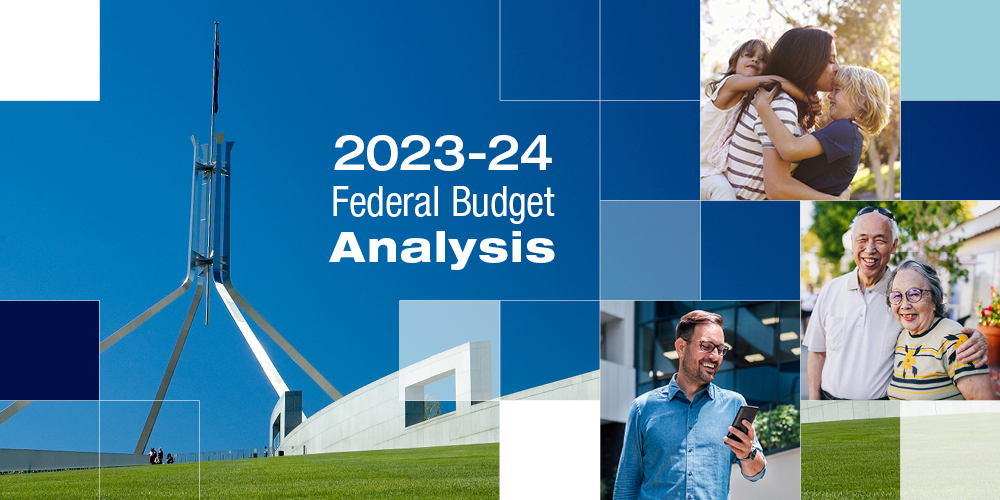
Federal Budget 2023-24 Analysis
A surplus for now but stormy seas ahead
Treasurer Jim Chalmers bills his 2023 Federal Budget as an economic strategy to help ease cost-of-living pressures.
To that end, he has delivered a modest but welcome package of cuts to healthcare, housing and energy costs as well as boosts to welfare payments for single parents and the unemployed.
Banking an unexpected bonus in increased tax revenue and rising commodity prices, the Albanese government has aimed to help the most disadvantaged while also looking ahead with new plans for renewable energy, defence and the arts.
But it has kept its spending under control to deliver a forecast $4.2 billion budget surplus – the first in 15 years.
The Treasurer sums up his second budget as “a plan for security, for prosperity, for growth”.
The big picture
While the first budget surplus in a decade and a half is to be celebrated, the joy will be short-lived. By next year’s budget, it’s expected there will be a return to small deficits for the next few years.
That’s because the global economy is slowing thanks to persistent inflation and higher interest rates. Aside from the pandemic and the 2007 Global Financial Crisis, the next two years are expected to be the weakest for global growth in more than two decades.
As a result, the government expects Australia’s economic growth to slow from 3.25 per cent in 2022-23 to just 1.5 per cent the following year, before recovering a little to 2.25 per cent.
In this environment, the treasurer continues to mark inflation as the government’s primary economic challenge. He says that is why the budget is “calibrated to alleviate inflationary pressures, not add to them”.
The good news is that the Reserve Bank says inflation is falling slightly faster than it had first forecast and has now passed its peak. It is expected to be around 4.5 per cent by the end of the year, a long way from last year’s CPI rate of 7.8 per cent.
Easing the cost of living
The government’s $14.6 billion package of cost cuts aimed at helping some of those most affected by rising costs covers energy bills, health and medical services, and welfare payments.
There will be energy bill relief to around five million households and one million small businesses. From July 2023, eligible households will receive up to $500 and eligible small businesses up to $650.
The government will also introduce a number of energy saving programs for households including low-interest loans and funds for upgrades to social housing. And there will be access to better information on reducing energy bills.
Health and medical
Countering a major expense for many, the government is pouring in billions of dollars to ease health and medical costs and access to services.
It will spend an extra $3.5 billion to provide incentives to doctors to bulk bill Concession Card holders and children under 16. It’s expected that the increased bulk billing incentive will help around 11.6 million people.
The cost of medicines is also likely to change for many who suffer chronic health conditions. From 1 September 2023, some patients will be eligible to be prescribed two months’ worth of medicine at a time, instead of one month’s worth. It’s expected this change will cut the number of visits to GPs and pharmacies, and the government estimates at least six million people will see their bills for medicines reduced by half.
The government is also providing $2.2 billion over five years for new and amended listings to the PBS, including treatment for cystic fibrosis.
Meanwhile, to improve access to care and reduce the strain on hospitals, a further $358.5 million will be spent to open a further eight Urgent Care Clinics. The clinics will bulk bill and remain open for longer hours.
Welfare boost
Income support payments including JobSeeker, Austudy and Youth Allowance will rise by $40 a fortnight following a concerted campaign by lobby groups in the months leading up to the budget.
And, recognising the extra challenges faced by older people looking for work, those aged 55 and over and out of work for at least nine continuous months, will now receive the higher rate JobSeeker payment currently paid to those over 60. Around 52,000 people will receive the increase of $92.10 a fortnight.
There will be more support for eligible single parents from September 2023. They will receive the Parenting Payment until their youngest child turns 14 (currently up to eight years old). Those receiving the payment will also benefit from more generous earning arrangements compared to JobSeeker. Eligible single parents with one child will be able to earn an extra $569.10 per fortnight, plus an extra $24.60 per additional child, before their payment stops.
Housing assistance
While rents continue to climb sharply around the country, the government has provided only limited assistance to renters. Those receiving Commonwealth Rent Assistance will see a 15 per cent increase in their payments from 20 September 2023.
Eligibility for the Home Guarantee Scheme will be expanded beyond first home buyers to include any 2 eligible borrowers beyond married and de facto couples, and non-first home buyers who have not owned a property in Australia in the preceding 10 years.
The government’s other housing initiatives are medium to long term solutions to the housing crisis.
There are new tax incentives to encourage the construction of more build-to-rent developments. The government claims an extra 150,000 rental properties could be delivered as a result in ten years.
The government is also focusing on providing more affordable housing by supporting more lending to community housing providers for social and affordable housing projects.
Pay rise for aged care workers
Severe staff shortages in the aged care sector, largely been driven by low wages, may abate a little with the government’s commitment to fund a pay rise.
More than $11 billion has been allocated to support an interim 15 per cent increase in award wages.
Support for families
Childcare will be cheaper from July 10, when the government subsidy will increase to 90 per cent for families on a combined income of $80,000 or less.
For families earning over $80,000, the subsidy rate will taper down by 1 percentage point for every additional $5,000 of family income until the subsidy reaches 0 per cent for families earning $530,000.
A more flexible and generous Paid Parental Leave scheme will also be introduced in July. A new family income test of $350,000 per annum will see nearly 3,000 additional parents become eligible for the entitlement each year.
Superannuation
Superannuation is in the government’s sights and employers and individuals with larger balances will be affected.
The concessional tax for those with balances exceeding $3 million will increase from 1 July 2025 to 30 per cent. Earnings on balances below $3 million will continue to be taxed at the concessional rate of 15 per cent.
Meanwhile from 1 July 2026, employers will have to pay their employees’ super at the same time they pay their wages. The government says that in 2019-20, employers failed to pay $3.4 billion of super owing to their employees.
Looking ahead
The stormy global economic outlook will keep Australia on its toes for the next two years or so but the government has attempted both to support those who are particularly vulnerable now and keep an eye to the future with some bigger thinking.
Moving forward, the government wants to position Australia a “renewable energy superpower” with a new Net Zero Authority to help attract new clean energy industries and help workers in coal regions to find new jobs.
The arts received a boost with almost $1 billion going to art galleries, museums, arts organisations and the film sector to help address “a decade of chronic underfunding”.
And there is the much debated investment in defence – more than $30 billion over the next ten years. Treasurer Chalmers says that while we may have a lot “coming at us – we have a lot going for us too”.
Information in this article has been sourced from the Budget Speech 2023-24 and Federal Budget Support documents.
It is important to note that the policies outlined in this publication are yet to be passed as legislation and therefore may be subject to change.
i RBA says inflation has passed its peak
ii https://www.rba.gov.au/publications/smp/2023/feb/economic-outlook.html
iii https://www.pm.gov.au/media/national-net-zero-authority
iv https://www.arts.gov.au/news/2023-24-federal-budget-revitalise-arts-sector
v https://minister.infrastructure.gov.au/burke/media-release/budget-2023-24-albanese-government-revives-australias-arts-and-culture

Federal Budget 2023-24: Focus on tax
Tax measures were less central to this year’s Federal Budget than they have been in recent years.
While there were some new tax measures, the Budget this year was more about the first surplus in 15 years and various spending measures.
After highlighting the gloomy outlook for the global economy, Treasurer Jim Chalmers emphasised Australia’s future as an “energy superpower”, with small business to be a key beneficiary.
Energy incentives for small business
The new Small Business Energy Incentive will provide businesses with annual turnovers under $50 million with a bonus 20 per cent deduction on expenditure supporting electrification and more efficient energy use.
Up to $100,000 of total expenditure will be eligible, with the maximum bonus tax deduction being $20,000 per business.
The assets or upgrades must be first used or installed ready for use between 1 July 2023 and 30 June 2024.
Tax support continues for business
Over 2 million eligible small businesses will also enjoy welcome cashflow relief, with the government halving the increase in quarterly tax instalments for GST and income tax in 2023-24. Instalments will only increase by 6 per cent, instead of the expected 12 per cent.
While businesses may enjoy the extra cashflow, the government is also increasing efforts to reduce tax avoidance and minimisation. There will be greater scrutiny of GST returns as the ATO will receive extra resources over the next four years to promote GST compliance.
The ever-popular instant asset write-off received another year of life, with small businesses permitted to immediately deduct eligible assets costing up to $20,000 from 1 July 2023 to 30 June 2024.
Super payments crackdown
The days of businesses having access to employee super payments for a quarter are over, with employers required to pay their employees’ super at the same time they pay their wages from 1 July 2026.
The ATO picked up an additional $27 million in 2023-24 to improve its data matching capabilities and $13.2 million for a new compliance system to identify in near-real time instances of under or unpaid super. There will also be new unpaid super recovery targets set for the ATO in 2023-24.
The Budget also confirmed legislation for the new tax on earnings from super balances exceeding $3 million will be introduced to Parliament. From 1 July 2025, these earnings will attract an increased concessional tax rate of 30 per cent.
New tax incentives for housing
Businesses in the residential housing sector are now eligible for some attractive incentives, with the Budget providing two new perks.
The capital works deduction (depreciation) rate will be increased from 2.5 per cent to 4 per cent a year for eligible new build-to-rent projects, while the withholding tax rate for eligible fund payments for build-to-rent developments will be reduced from 30 per cent to 15 per cent.
Support measures for smaller business
The Budget unveiled several support measures, including timely relief for businesses’ electricity bills. From July 2023, an estimated one million eligible small businesses will receive up to $650 in assistance.
Over $23 million will also be invested to help small businesses train in-house cyber wardens to deal with cyber security attacks.
A further $392 million Industry Growth Program will be available help support small to medium sized businesses and start-ups develop new products and services.
Other tax measures
The Budget also included changes to the Petroleum Resources Rent Tax (PRRT). These will collect an additional $2.4 billion over four years by limiting to 90 per cent the proportion of PPRT assessable income that can be offset by deductions.
Tobacco excise taxes will also increase, rising by 5 per cent each year for three years from 1 September 2023.
The government is also getting behind the OECD’s push for a minimum 15 per cent tax rate for multinationals.
Despite strong lobbying, the planned third tranche of tax cuts legislated to come into effect next year survived the Budget process and as expected, the low and middle income tax offset was not extended beyond 2021-22.
Information from this article has been sourced from: https://budget.gov.au/

Why an emergency fund delivers peace of mind
When life tosses up an unexpected event – such as retrenchment, a medical emergency or even just a big bill to fix the car – it can be nerve-wracking worrying about how to deal with the crisis. And, if funds are short, that just adds to the stress.
But imagine that you have a secret cash stash – an emergency fund – that will cover the costs, giving you the mental space to deal with the problem.
In fact, an emergency fund is the basis for a strong financial strategy and provides a crucial safety net. It makes sense regardless of your age or income because the unexpected can happen to anyone.
Without a cash reserve, you may have to rely on credit cards or loans, which can put a further strain on your financial situation and your mental health.
An emergency fund gives you the peace of mind to be able to weather the storms that come your way without racking up unwanted debt and interest payments.
How much is enough?
Of course, it can be tough to save when inflation is eating away at your income. Rising interest rates, rents and the cost of groceries is putting a big strain on households. The Australian Bureau of Statistics reports that household savings have been declining for more than a year as people contend with increased mortgage payments among the other rising costs.i
Nonetheless, by putting aside even a small but regular payment into a separate fund you will slowly accumulate enough to cover emergencies.
The size of your emergency fund depends on your own circumstances but an often quoted target is enough to cover between three and six months of living expenses.
It may differ if say, you are planning on starting a family and need funds in reserve to cover the difference between parental leave payments and a salary; you have children in school and want to be able to cover school fees for a year or more, no matter what happens; you need to take time off work to care for a family member; or you need to make an unplanned trip.
On the other hand, if you have retired, it can be helpful to have a buffer against market volatility. If there is a downturn in the markets and your superannuation is not providing your desired level of income, a year’s worth of living expenses in an emergency fund can make all the difference to your lifestyle.
The main thing to remember is that if you need to raid your emergency fund, start work on rebuilding it as quickly as possible.
Building your fund
Putting together a budget can help you to analyse how much you can afford to put away every week, fortnight or month. Then, consistently saving until you reach your goal is the key, no matter how small the amount.
It is best to keep your emergency fund separate from your everyday transaction account to reduce the chance of you using your saved funds for regular expenses. One option is to pay yourself first by setting up a direct debit, so your emergency fund grows automatically with no extra action needed from you, and to avoid the temptation to withdraw your savings.
The type of account you choose for your emergency fund is important. It should be readily available so, while shares and term deposits may offer higher returns, they are not quickly accessible when required. Shop around for a bank account that offers the highest interest to get the most out of your hard-earned income.
Building an emergency fund is an essential component of a strong financial plan, providing a safety net should something unexpected arise. If you are unsure of the best way to set up an emergency fund, we encourage you to reach out to us. We can provide guidance on the best options for your unique financial situation and help you take steps towards




